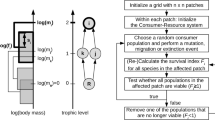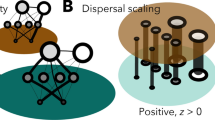Ecologists increasingly recognize that a consideration of spatial dynamics is essential for resolving many classical problems in community ecology. In the present paper, I argue that understanding how trophic interactions influence population stability can have important implications for the expression of spatial processes. I use two examples to illustrate this point. The first example has to do with spatial determinants of food chain length. Prior theoretical and empirical work has suggested that colonization–extinction dynamics can influence food chain length, at least for specialist consumers. I briefly review evidence and prior theory that food chain length is sensitive to area. A metacommunity scenario, in which each of various patches can have a food chain varying in length (but in which a consumer is not present on a patch unless its required resource is also present), shows that alternative landscape states are possible. This possibility arises if top predators moderate unstable interactions between intermediate predators and basal resources. The second example has to do with the impact of recurrent immigration on the stability of persistent populations. Immigration can either stabilize or destabilize local population dynamics. Moreover, an increase in immigration can decrease average population size for unstable populations with direct density-dependence, or in predator–prey systems with saturating functional responses. These theoretical models suggest that the interplay of temporal variation and spatial fluxes can lead to novel qualitative phenomena.
Similar content being viewed by others
REFERENCES
Abrams P. A. (1992) Why don’t predators have positive effects on prey populations? Evolutionary Ecology 6: 449–457.
Abrams P. A. & Roth J. D. (1994) The effects of enrichment of 3-species food-chains with nonlinear functional-responses. Ecology 75: 1118–1130.
Belyea L. R. & Lancaster J. (1999) Assembly rules within a contingent ecology. Oikos 86: 402–416.
Bonsall M. B. & Hassell M. P. (2000) The effects of metapopulation structure on indirect interactions in host-parasitoid assemblages. Proceedings of the Royal Society of London Series B-Biological Sciences 267: 2207–2212.
Cohen J. E. & Newman C. M. (1985) A stochastic-theory of community food webs.1. Models and aggregated data. Proceedings of the Royal Society of London Series B-Biological Sciences 224: 421–448.
Cohen J. E. & Newman C. M. (1991) Community area and food-chain length – theoretical predictions. American Naturalist 138: 1542–1554.
Doebeli M. (1995) Dispersal and dynamics. Theoretical Population Biology 47: 82–106.
Ekerholm P., Okansen L. & Okansen T. (2001) Long-term dynamics of voles and lemmings at the timberline and above the willow limit as a test of hypotheses on trophic interactions. Ecography 24: 555–568.
Elton C. S. (1927) Animal Ecology. Sidgwick and Jackson, London.
Hassell M. P. (2000) The Spatial and Temporal Dynamics of Host–Parasitoid Interactions. Oxford University Press, Oxford.
Holt R. D. (1983a) Immigration and the dynamics of peripheral populations. In: Advances in Herpetology and Evolutionary Biology. (eds K. Miyata & A. Rhodin) pp. 680–694. Museum of Comparative Zoology, Harvard University, Cambridge, Massachusetts.
Holt R. D. (1983b) Models for peripheral populations: The role of immigration. In: Lecture Notes in Biomathematics. (eds H. I. Freedman & C. Strobeck) pp. 25–32. Springer-Verlag, Berlin.
Holt R. D. (1992) A neglected facet of island biogeography – the role of internal spatial dynamics in area effects. Theoretical Population Biology 41: 354–371.
Holt R. D. (1993) Ecology at the mesoscale: The influence of regional processes on local communities. In: Species Diversity in Ecological Communities. (eds R. Ricklefs & D. Schluter) pp. 77–88. University of Chicago Press, Chicago.
Holt R. D. (1996) Food webs in space: an island biogeographic perspective. In: Food Webs: Contemporary Perspectives. (eds G. A. Polis & K. Winemiller) pp. 313–323. Chapman & Hall, New York.
Holt R. D. (1997a) Community modules. In: Multitrophic Interactions in Terrestrial Systems. (eds A. C. Gange & V. K. Brown) pp. 333–349. Blackwell Science, Oxford.
Holt R. D. (1997b) From metapopulation dynamics to community structure: some consequences of spatial heterogeneity. In: Metapopulation Biology. (eds I. Hanski & M. Gilpin) pp. 149–164. Academic Press, New York.
Holt R. D., Lawton J. H., Polis G. A. & Martinez N. D. (1999) Trophic rank and the species-area relationship. Ecology 80: 1495–1504.
Holyoak M. (2000) Habitat subdivision causes changes in food web structure. Ecology Letters 3: 509–515.
Huxel G. R. & McCann K. (1998) Food web stability: The influence of trophic flows across habitats. American Naturalist 152: 460–469.
Jansen V. A. A. (1995) Regulation of predator-prey systems through spatial interactions: a possible solution to the paradox of enrichment. Oikos 74: 384–390.
Komonen A., Penttila R., Lindgren M. & Hanski I. (2000) Forest fragmentation truncates a food chain based on an old-growth forest bracket fungus. Oikos 90: 119–126.
Law R. & Morton R. D. (1993) Alternative permanent states of ecological communities. Ecology 74: 1347–1361.
Lockwood J. L., Powell R. D., Nott M. P. & Pimm S. L. (1997) Assembling ecological communities in time and space. Oikos 80: 549–553.
MacArthur R. H. & Wilson E. O. (1967) The Theory of Island Biogeography. Princeton University Press, Princeton, NJ.
McCallum H. I. (1992) Effects of immigration on chaotic population-dynamics. Journal of Theoretical Biology 154: 277–284.
May R. M. (1973) Time-delay versus stability in population models with 2 and 3 trophic levels. Ecology 54: 315–325.
Mikkelson G. M. (1993) How do food webs fall apart? A study of changes in trophic structure during relaxation on habitat fragments. Oikos 67: 539–547.
Morton R. D. & Law R. (1997) Regional species pools and the assembly of local ecological communities. Journal of Theoretical Biology 187: 321–331.
Nakano S. & Murakami M. (2001) Reciprocal subsidies: Dynamic interdependence between terrestrial and aquatic food webs. Proceedings of the National Academy of Sciences of the United States of America 98: 166–170.
Pimm S. L. (1982) Food Webs. Chapman & Hall, London.
Pimm S. L. & Lawton J. H. (1977) The number of trophic levels in ecological communities. Nature 275: 542–544.
Polis G. A., Anderson W. B. & Holt R. D. (1997) Toward an integration of landscape and food web ecology: The dynamics of spatially subsidized food webs. Annual Review of Ecology and Systematics 28: 289–316.
Polis G. A. & Winemiller K., eds. (1996) Food Webs: Integration of Pattern and Process. Chapman & Hall, New York.
Post D. M. Broadening the discourse on food-chain length. Trends in Ecology and Evolution (in press).
Post D. M., Pace M. L. & Hairston N. G. (2000) Ecosystem size determines food-chain length in lakes. Nature 405: 1047–1049.
Power M. E. & Rainey W. E. Food webs and resource sheds: Towards spatially delimiting trophic interactions. In: Ecological Consequences of Habitat Heterogeneity. (ed. Z. Kawabata). Blackwell Science, Oxford. (in press)
Ritchie M. E. (1999) Biodiversity and reduced extinction risks in spatially isolated rodent populations. Ecology Letters 2: 11–13.
Ritchie M. E. & Olff H. (1999) Spatial scaling laws yield a synthetic theory of biodiversity. Nature 400: 557–560.
Roland J. & Taylor P. D. (1997) Insect parasitoid species respond to forest structure at different spatial scales. Nature 386: 710–713.
de Roos A. M., McCauley E. & Wilson W. G. (1998) Pattern formation and the spatial scale of interaction between predators and their prey. Theoretical Population Biology 53: 108–130.
Rosenzweig M. L. (1973) Exploitation in 3 trophic levels. American Naturalist 107: 275–294.
Rosenzweig M. L. (1995) Species Diversity in Space and Time. Cambridge University Press, UK.
Rosenzweig M. L. & Macarthur R. H. (1963) Graphical representation and stability conditions of predator–prey interactions. American Naturalist 97: 209–223.
Ruxton G. D. & Rohani P. (1998) Population floors and the persistence of chaos in ecological models. Theoretical Population Biology 53: 175–183.
Schneider D. W. (1997) Predation and food web structure along a habitat duration gradient. Oecologia 110: 567–575.
Schoener T. W. (1989) Food webs from the small to the large. Ecology 70: 1559–1589.
Schoener T. W., Spiller D. A. & Morrison L. W. (1995) Variation in the Hymenopteran parasitoid fraction on Bahamian islands. Acta Oecologica-International Journal of Ecology 16: 103–121.
Sears A. L. W., Holt R. D. & Polis G. A. Feast and famine in food webs: the effects of pulsed productivity. In: Food Webs at the Landscape Scale: the Ecology of Trophic Flow Across Habitats. (eds G. A. Polis, G. R. Huxel & M. Power). University of Chicago Press, Chicago. (in press).
Spencer M. & Warren P. H. (1996) The effects of habitat size and productivity on food web structure in small aquatic microcosms. Oikos 75: 419–430.
Steffan-Dewenter I. & Tscharntke T. (2000) Butterfly community structure in fragmented habitats. Ecology Letters 3: 449–456.
Sterner R. W., Bajpai A. & Adams T. (1997) The enigma of food chain length: Absence of theoretical evidence for dynamic constraints. Ecology 78: 2258–2262.
Stone L. (1993) Period-doubling reversals and chaos in simple ecological models. Nature 365: 617–620.
Stone L. & Hart D. (1999) Effects of immigration on the dynamics of simple population models. Theoretical Population Biology 55: 227–234.
Tilman D. & Kareiva P., eds. (1997) Spatial Ecology: the Role of Space in Population Dynamics and Interspecific Interactions. Princeton University Press, Princeton, NJ.
Townsend C. R., Thompson R. M., McIntosh A. R., Kilroy C., Edwards E. & Scarsbrook M. R. (1998) Disturbance, resource supply, and food-web architecture in streams. Ecology Letters 1: 200–209.
Van Nouhuys S. & Hanski I. (1999) Host diet affects extinctions and colonizations in a parasitoid metapopulation. Journal of Animal Ecology 68: 1248–1258.
Weisser W. W., Jansen V. A. A. & Hassell M. P. (1997) The effects of a pool of dispersers on host-parasitoid systems. Journal of Theoretical Biology 189: 413–425.
Whittaker R. J. & Jones S. H. (1994) Structure in re-building insular ecosystems – an empirically derived model. Oikos 69: 524–530.
Wilson H. B., Hassell M. P. & Holt R. D. (1998) Persistence and area effects in a stochastic tritrophic model. American Naturalist 151: 587–595.
Yodzis P. (1988) The indeterminacy of ecological interactions as perceived through perturbation experiments. Ecology 69: 508–515.
Author information
Authors and Affiliations
Corresponding author
About this article
Cite this article
Holt, R. Food webs in space: On the interplay of dynamic instability and spatial processes. Ecol Res 17, 261–273 (2002). https://doi.org/10.1046/j.1440-1703.2002.00485.x
Received:
Accepted:
Issue Date:
DOI: https://doi.org/10.1046/j.1440-1703.2002.00485.x




